*The SKS*
By Shooter
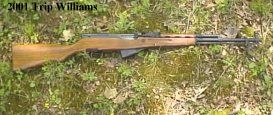
The SKS has the "honor" of symbolizing today's survivalists better, perhaps, than any other weapon. Ten years ago, an SKS and 1000 rounds of ammunition could be bought for around $150. Even after the current import ban on SKS's, they remain a viable and reasonably priced weapon. Their reliability and user-friendliness make up for what they lack in looks.
Like most AK's, RPK's and various clones, the SKS is also chambered for the 7.62x39 cartridge. It is a 10-shot, semiautomatic carbine (a select-fire version DOES exist), firing from a fixed magazine. The magazine may be loaded via single rounds or by 10-round stripper clips. A stripper clip guide is machined into the face of the bolt carrier. The magazine floorplate hinges downward for easy unloading.
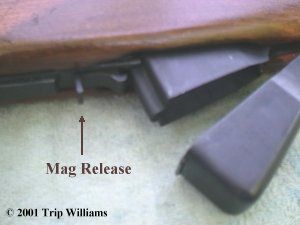
A pivoting safety is located on the right rear of the trigger guard.
The SKS was the first weapon to be chambered for the 7.62x39 Soviet intermediate cartridge. Some experts claim that the Soviets stole the cartridge's design from the German 7.92 Kurtz. Be aware, a very FEW SKS's did enter the country (all made by NORINCO in China) which were chambered for the 5.56 NATO cartridge, so be sure which one you have.
SKS's have been manufactured in Russia, most former Soviet-bloc countries and China. Most SKS's in the US are either Russian or Chinese. However, some Romanian and Yugoslavian SKS's do turn up on the market every now and then. The SKS was derived near the end of WWII by Soviet arms-makers in an attempt to provide a robust, yet easily produced replacement for the Tokarev SVT, chambered for the full powered 7.62x54 cartridge. The Soviets needed a mass-produced weapon on par with the US M1 Garand and German Gew 43. There is some speculation that the rifle is nothing more than a scaled-down version of a Soviet anti-tank rifle in use at that time.
The SKS was in service as a frontline weapon only until the AK-47 design could be finalized and production started. As soon as enough AK-47's were produced to arm frontline Soviet troops, the SKS was relegated to secondary and ceremonial service, much as is the case with the US M-14.
The SKS is a gas-operated weapon, very similar to the AK-47 which fires the same cartridge. When the SKS is fired, propellant gases are bled off through a gas port located on top of the barrel, again, as with the AK. These gases push back on the gas piston, which in turn strikes the bolt carrier by means of a spring-loaded piston rod. As the bolt is pushed backwards into the receiver, it cocks the hammer and on its return trip, strips a fresh cartridge from the 10-shot magazine and chambers it.
Field Stripping the SKS
To field strip the SKS, FIRST make sure the weapon is UNLOADED and VISUALLY verify that the chamber is EMPTY. WARNING! Most parts are under spring pressure, so do not point the weapon towards your face during disassembly. The wearing of safety glasses is highly recommended!
On the right rear of the receiver is the receiver cover latch. Rotate this latch upward. While applying forward pressure against the receiver cover, pull the cover pin out to the right as far as it will come. It is a captive pin, so it cannot be removed from the receiver. Remove the receiver cover by sliding it rearward and off.
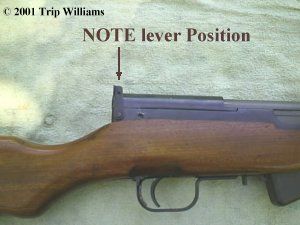
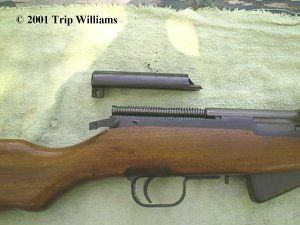
Remove the recoil spring assembly from the bolt carrier by compressing it slightly and disengaging it from its machined notch in the receiver. The bolt and bolt carrier may now be removed by pulling back on the operating handle and lifting out. The bolt may now be removed from the carrier.
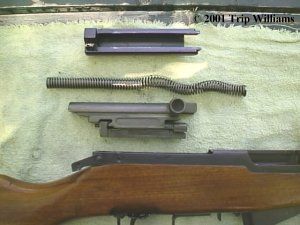
The gas cylinder tube lock, located on the right side of the gas block below the rear sight base, must be rotated upward SLIGHTLY in order to remove the gas tube. The gas tube rod is in two parts, one part, the short "gas rod plunger" and spring, is under spring pressure under the rear site, the forward part (in the gas tube) simply lays in the gas tube housing. If you stand this lever straight up at this point the two part gas rod spring and plunger will fly out from under the rear site mount! See the image below for the correct position to remove the gas tube. Once removed from the weapon, the gas piston will slide out out of the front of the gas tube.
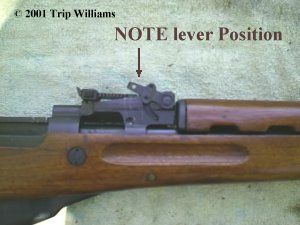
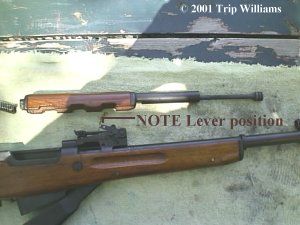
NOW you can stand the gas tube lever straight up to remove the short gas rod plunger and spring, be ready to catch it as it will come out with some force when the lever is rotated fully upwards. During reassembly you will need this lever in the upward position, put the rod and spring back in and push it fully rearward with a cleaning rod and then push the lever downward to it's 45 degree position, this will lock the spring and short rod back into place.
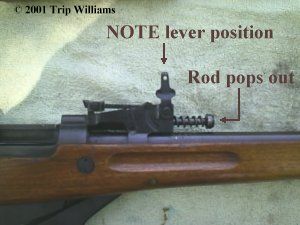
To remove the barreled action from the stock, first remove the cleaning rod. Then, using a punch, screwdriver or cartridge tip, depress the plunger at the bottom rear of the trigger guard. The trigger guard/magazine housing assembly will unlock from the receiver and swing down. The barreled action may then be lifted up and out of the stock.
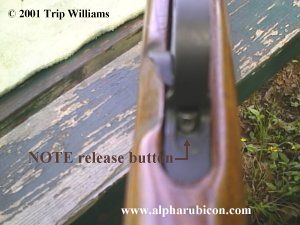
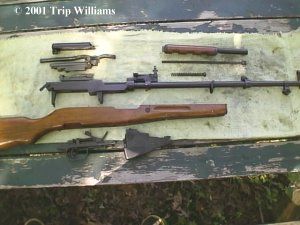
Reassemble in reverse order.
To load the weapon and make ready to fire, first, engage the safety by rotating it upward, making sure that it is parallel to the receiver. Pull the bolt handle to the rear. The action should lock open. Align a loaded stripper clip with the clip guide and apply pressure with your thumb to the top cartridge. Continue applying pressure until the magazine is loaded with 10 rounds.
To chamber a round, pull back slightly on the bolt handle and let it go. The bolt will strip the top cartridge from the magazine and chamber it. The weapon is now ready to fire. After all 10 rounds are expended, the bolt will lock back to the rear, indicating an empty weapon and readying it for reloading.
Shooter
Return to The Alpha Group Web Page
 Send Warlord E-mail.
Send Warlord E-mail.
Address: 
All materials at this site not otherwise credited are Copyright © 1996, 1997, 1998, 1999, 2000 Trip Williams. All rights reserved. May be reproduced for personal use only. Use of any material contained herein is subject to stated terms or written permission.











